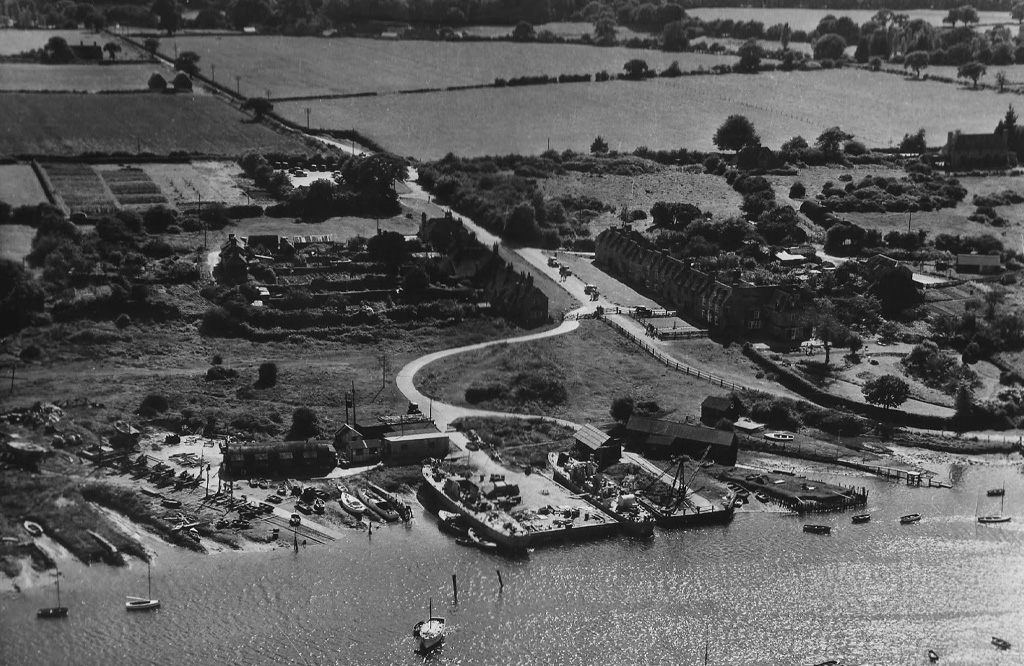History
The Shipyard at Buckler’s Hard
From the time of Beaulieu Abbey in 1204 it is thought that there was boatyard on this gravel corner of the Beaulieu River stop where the tidal water does not dry out and ships would have stopped with their heavy loads going upstream.
In 1698 the Royal Navy did a survey of the south coast looking for good sites for shipbuilding and it was identified as excellent on many counts. A sheltered navigable river, gravel banks to support slipways for construction and launching of ships and most important access to a lot of timber in the surrounding woodland and all close the navy dockyard in Portsmouth.
The first Royal Navy ship was built 1698 on the riverbank, possibly upstream of Buckler’s Hard in the next bend of the river at Bailey’s Hard – the HMS Salisbury 48 guns. Not a huge success as the shipwright could not complete the contract and it was taken over by the landlord, the 1st Duke of Montagu to finish and deliver.
In 1724 the village was born as ‘Montagu Town’. This was developed as a trading freeport, a wood was felled and a new road created from Beaulieu and the village was built with the two rows of cottages and storehouses along with quays, slipways and wharfs.
In 1744 Henry Adams, a master shipwright, was sent from Deptford Dockyard to Buckler’s Hard by the Admiralty to oversee the building of ships by James Wyatt, a shipwright from Bursledon. After the completion of the initial ships by Wyatt, Henry Adams won subsequent Royal Navy contracts, taking over the tenancy of the shipyard and Shipyard House, where he lived. He and his sons built over 50 ships for the Royal Navy. It was the most prolific private shipyard by far, building twice as many ships than any other private yards in its time.
The shipyard grew and in the 1770’s the slipways were reconfigured to be able to build and launch the much bigger ships required by the Navy, the 64 and 74 gun ships.
The yard had many buildings, two forges, mould loft, saw pits, two timber yards, stores and temporary accommodation. The workforce of well over a hundred men, 35 skilled shipwrights, caulkers, sawyers, carters, blacksmiths and masses of labourers and their families dominated the whole village and area, a huge industrial site, 12 hour days, 6 days a week, physically tough, housed in cottages, shacks, on boats and on the local farms.
Once a contract to build a ship had been awarded, the Navy Board sent designs and plans which were scaled up into patterns in the mould loft. The individual pieces were then cut from seasoned timber, specially selected for size and shape. The solid parts of the trunk were used for stem and stern posts, whilst the knees that strengthened the joint between the deck and the hull, or main body of the ship, were cut from the junction of the branches with the trunk. Sawyers, working in pairs, cut the timber to specified lengths before the highly skilled shipwrights shaped and fitted the timbers together using adzes, augers and hatchets.
The ships were constructed on launchways sloping down into the river. The first part to be built was the keel, which was raised on blocks so the men could work beneath; this was followed by the stem, stern and frame. Pillars supported the decks, and large iron or copper bolts were used to fasten the timber beams. The next stage was the fitting of an outer and inner layer of planking, steamed to fit the curves of the hull. Treenails, made of the same wood to help prevent rotting, fixed the planking in place. Once the hull had been completed, caulkers made it waterproof by filling the seams with oakum or strands of old rope, and hammering it in tightly with caulking irons and a mallet. The seams were then sealed with hot pitch. The ship was now ready to be launched and towed to Portsmouth to be fitted out with masts, rigging, sails, guns, ballast and provisions before it being commissioned.
Launch day was a big community event, with the larger ships attracting crowds of 1000’s, much celebrating and a day off for the workforce as they watched their ships head off downstream being towed on the tide over 5 days to Portsmouth by a team of royal Navy Gigs. Once in the Royal Dockyard it took only around 12 weeks to fully rig, equip with armament and supplies before going off for sea trails and service
In 1815, peace with France meant that the Navy needed many less ships. The shipyard continued to build Merchant ships for world trade, work boats and later gentlemen’s yachts.
By 1835 all shipbuilding has stopped and the village went into severe economic decline. The New Forest was a poor agricultural area, there was no coal, no industrial revolution here, no big trees left, and many immigrated, leaving the village to be lived in by a few local families and retired shipwrights.
The end of Edward Adams’ tenancy of the shipyard in 1847 marked the end of the shipbuilding era completely. Like many other industries, shipbuilding was now concentrated in towns and cities and required larger workforces and new materials such as iron replaced timber. Skilled people moved from the country to find employment and by the time of the 1851 Census, Joseph West, aged 73, was the only shipwright still living in Buckler’s Hard.
The Shipyard buildings slowly fell down with only the Blacksmiths Forge building remaining until around 1910.
The whole area remained so undisturbed, a quiet forgotten part of the country. But in the 1870’s, there was a threat of development to the New Forest lands to be sold for housing. A movement for the appreciation of the aesthetic value of woodlands, the historic landscape, built heritage and past history grew – a conservation movement was born and tourism blossomed.
New transport such as steamships, the train line not far away, motor cars and charabang buses, brought visitors – the shipyard of old became an early heritage destination. In 1894, the saloon steamer came from Gosport to see the’ place where Nelson’s wooden men o war were built.’
The Second World War comes to Buckler’s Hard
The Second World War saw Buckler’s Hard and the Beaulieu River once more in the country’s service for the Navy. At the outbreak of war, the Admiralty ordered the removal of all boats and installed a log boom across the river mouth to deter enemy craft. Initially, Buckler’s Hard had a concrete slipway installed so it could be used as a repair and service base for motor torpedo boats – but as the war progressed, the demands on the river increased.
In 1941, Bailey’s Hard was requisitioned as a base for Husbands’ Shipbuilders to fit out their wooden minesweepers. The following year, the Harbour Master and his assistant were seconded to the Admiralty and in 1943 the village itself was requisitioned for naval personnel and their activities.
The Master Builder’s House had been used by officers since the start of the war (with the ratings put up in hastily erected Nissen huts) but now a top secret operation required military police to occupy all rooms facing the Hard. The closely-guarded secret was ‘Operation Quicksilver’, a deception plan in which dummy landing craft were built for mooring on rivers and harbours in the south-east. Built by the Pioneer Corps, the purpose of these dummies, called ‘Bigbobs’, was to fool the Germans into thinking that any invasion would take place in the area around Calais. 100 Thames Barge Lighters were towed to the river and converted into landing craft.
The next project saw the old oyster beds off Clobb Copse occupied by men from Wates the Builders and the Marley Tile Company. The 100-strong workforce were engaged in making segments of ‘Mulberry Harbour’ which were towed across to the Normandy coast for the D-Day landings. They built over fifty concrete ‘Bigbob’ pontoons needed to support the harbours’ floating roadways. These 80 x 60 foot concrete accommodation and storage chambers were launched by knocking down a temporary retaining wall adjoining the river. The site was also used to build a concrete Admiralty Floating Dock (AFD33) large enough to take a tank landing craft and was launched in April 1944.
Lieutenant Commander Nevil Shute Norway RNVR, well known for his novel Requiem for A Wren, about HMS Mastodon at Exbury, worked in the Department of Miscellaneous Weapons Development. He used the Beaulieu River to experiment with Swallow, a rocket-propelled pilotless aircraft. D-Day came too soon for it to play a part, but the results were later used to develop guided weapons systems. The build-up to the D-Day landings in Normandy on 6th June 1944 saw unprecedented activity on the Beaulieu River as it filled with a variety of landing craft and associated ancillary units. King George VI visited HMS Mastodon at Exbury on 24th May, then sailed down the river, informally reviewing the thousands of army and navy personnel, gathered on or around the river in anticipation of an order to sail.
Finally, on 4th June, the signal came and the craft began their uncertain journeys; some foundered before reaching their destination, but many more played their part in the landings before running a shuttle service of troops and vehicles to sustain the Allied advance through Normandy.

The RN was paying just £50 a year for the whole river and was in no hurry at the end of the war to give it back.. it was not until 1947 that it returned it to the estate and the shipyard turned back into a civilian boat yard, now servicing the yachts and motor boats of the fast expanding leisure boating clientele.
The shipyard continued in use as a general boatyard until 1971, when it was moved upstream 400 m to a new location, away from the historic village and where new facilities such as a marina and new boatyard were constructed.
The historic shipyard site was preserved, never built over and so remains one of the only of its kind to exist.


